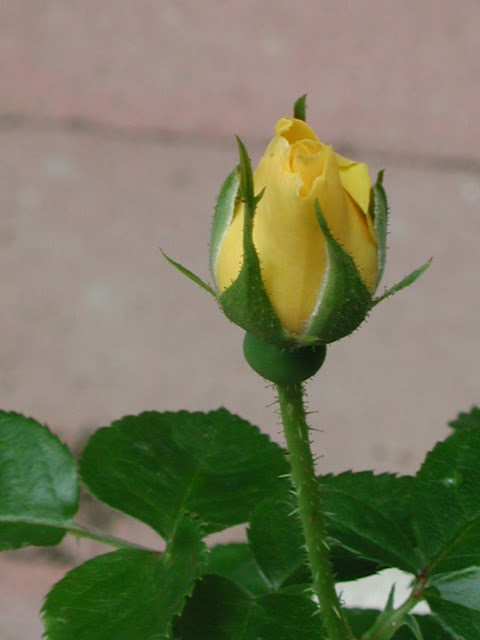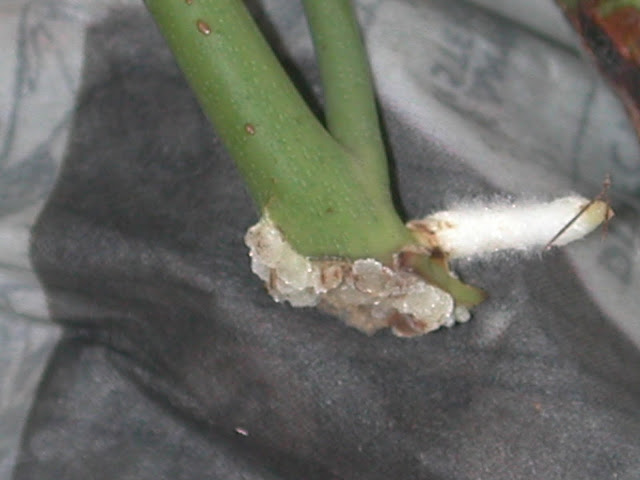Why should wrapping cuttings and maintaining them in the lower temperatures work better?
First, remember the instructions on packaged bare roots about mounding? The idea is keeping the plant cool, dark and damp stimulates the formation of roots instead of top growth. Absence of light and heat combined with dampness is what roots grow in. Adding heat and light stimulate leaf, cane and flower bud growth.
Wrapping the cuttings in damp paper simulates damp earth, as does the darkness. Keeping them cooler prevents formation of the chemicals which trigger top growth, favoring the formation of callus and roots instead. The cuttings already contain the programming to form callus which further develops into roots. Providing them the appropriate conditions to favor that kind of development speeds the process along. Holding them in higher or warmer temperatures stimulates both growth and callus, often the former at the disadvantage of the latter.
The whole reason for the rose to grow is to create flowers. The whole reason for the creation of flowers is to attract pollinators to create seed and perpetuate the species before the plant dies. Pollinators and the plants evolved together. The more successful roses broke into growth and flower as the appropriate pollinators arrived. Both were stimulated into the appropriate state of development simultaneously. Providing different conditions than those outside "trick" the rose into doing what is wanted from it, much like the Romans passing steam under potted roses to force them into flower out of season. Also, much like forcing Paper White Narcissus into flower earlier than usual for the holidays.
If your temperatures are already higher than the suggested sixty to almost seventy degree temperature range which I've found beneficial, why not wrap them, and presuming you have enough room, put them in your vegetable crisper? Prevent them from freezing, of course, but the cooler temperatures in the fridge should also stimulate callusing, though probably at a slower rate. Rose roots continue growing in near freezing soil. Not as quickly as they do in warmer soil, but they do still grow. You might find the need to hold them for three weeks at the lower temps than is optimal at the upper end of the suggested range. Only experimentation will determine that.
I've been repeatedly asked about my potting soil. I have some humidity and more than a little heat. Though no where near as extreme as many other places, it does get HOT here now. The evaporation rates are quite high, yet the evenings remain cooler and even with the heat, it is still humid enough to rot plants sealed under plastic or inside a terrarium. For these reasons, I use moisture control potting soil. If your humidity is greater so evaporation is slower, that man remain too wet for the conditions, rotting the cuttings. Many years ago when propagating for The Huntington Library as a volunteer, using their mist propagator, we used half coarse builders sand and half perlite. It remained damp after the water drained through it, but it also had a lot of air space in the mix so the cuttings didn't rot.
I've known people who tried to replicate the mist propagator and failed because of using organic based soil mix. Continuous wetness causes organics to sour. Dampness works, constant watering, doesn't. The wetter and more humid it is, the more open and fast draining you need your soil mix to be. Same holds for cool temps. Hotter and drier makes for greater evaporation, hence greater water holding capabilities.
It's dramatic the difference humidity makes. My old climate had none (usually) and required keeping everything covered in plastic or they'd die nearly immediately. Here, covering anything in plastic results in it molding nearly immediately. I've never been able to just stick any kind of cutting in a pot in the shade and have it root, but I've done it with hibiscus over winter. I'm going to mess with Mutabilis this winter attempting the same thing. I figured I'd have to put callused rose cuttings under plastic once planted out, but they're forming roots with half day full sun in foam cups. That wouldn't have happened in Santa Clarita. But, then, I never had the fungal issues there I have here, so the humidity is far different. I can FEEL it here, I couldn't there 99% of the time.
The best way is to get a handle on your humidity and how it varies with the year (presuming it does). Surf and absorb all the various methods you find explained and develop one combining the best of all of them, tweaked to your heat and humidity, then begin experimenting with it to see how it has to evolve to work where you are with what you are trying to propagate.
Once you figure out your humidity and evaporation rate, you can determine what kind of soil is best for you to use. You can also decide whether or not you need to cover the cuttings once callused. I'm finding planting them deeply in the soil to maintain cooler, damper, darker conditions, is working quite well without rotting or drying out before rooting. Think of the cutting in terms of a bare root plant as they really do require the same conditions until they form the root system necessary to support the leafed out plant.
























